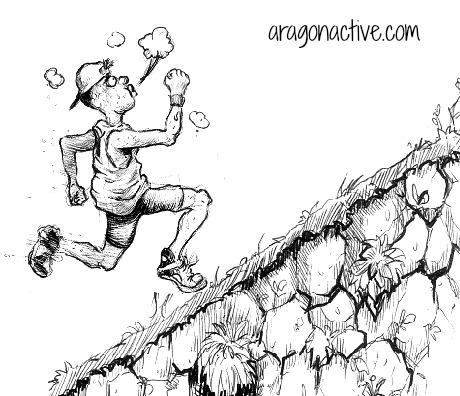Running Technique and Training for Hills

Specificity
To state the obvious, Trail Running generally includes hills. They can vary greatly in length and technical difficulty. Some hill climbs you may be able to run up, some may be so steep you need to walk. Descents are the same, whether it be a wide smooth surfaced dirt road or a rocky twisting single track.
So, to establish a running technique and training for hills, the first key question is specificity – what are you training for?
 That decided you then need to set your workouts to replicate as close as you can the types of climbs and descents you will be running, walking, or in the case of the penguins hoping!
That decided you then need to set your workouts to replicate as close as you can the types of climbs and descents you will be running, walking, or in the case of the penguins hoping!
If you are training for a specific event then there is nothing better than getting out on the course.
For example; I currently have a few athletes training for Ultra Trail Australia, a 100km event in the Blue Mountains west of Sydney.
This event contains nasty irregular stair climbs which sap energy, making it hard to get into a rhythm. It also includes long dirt road descents which can really hammer the quads. So as a running coach I set out specific workouts for my athletes, getting the body used to this variation, such as stair reps and getting out on some technical trail.
When I guide on Trail Running Holiday we are running over varied terrain, with both uphill and downhill included in all the routes. Take a look at this 45 second graphic. This is one of my favourite routes, which includes both farm track and single track. My time was 2 hrs 49 min, as shown on the video, but please bear in mind with our running groups we allow 4 to 4 ½ hours.
The beauty of this week long Trail Running Holiday is that we always have two running guides, so there is never any pressure on keeping up with lead runner. You run at your own pace. There is also plenty of time during the week to talk about running technique and training for hills, as well as other subjects like gear and nutrition. Gillian, a runner who joined us in 2016 and will be returning in 2017 summed it up when she wrote..
“If you like trail running, you’ll love this holiday. Hill training is good idea prior to the holiday, but the guides were able to cater for different levels of fitness and pace without any issues.”
Running Technique and Training for Hills
Before we get into specific sessions or workouts let’s run through some basic technique.
Uphill
As you start uphill, shorten your stride.
You are aiming for equal effort going up as well as down, not equal pace.
Take ‘granny steps’ if necessary and try to keep the same turnover rhythm (cadence) that you had on the flat ground.
Your posture should be upright. Keep your feet low to the ground.
Use your breathing as a guide to effort. You should still be in control and not “grabbing” for breath. You may need to slow down or shorten your stride or even walk (there’s no shame in that).
Downhill
Downhill running can be quite hard on the body and cause soreness especially in the quadricep muscles. Training can help the legs adapt. Good running form is also important.
Aim for an upright posture.
Vary your foot strike and keep your feet close to the ground for extra control. Try to be light footed.
Your strides will automatically be longer but don’t over-stride. Increase your cadence (stride frequency).
Stay in control, try and relax and not “put on the brake”.
Initially practice on “technical” trail that you are familiar with as this will give you greater confidence and you will be able to pay attention to your running form.
Sample Hill Training Sessions
Firstly, don’t do more than one hill session in a week as it is hard on the body so if you are not careful can lead to injury.
 Hill Intervals: Find a slope, preferably on grass, that is 50-250m in length and not too steep to prevent running. It can be road or smooth trail. After a warm up, run the uphill at an effort level harder than your 10km pace, which is quite hard if you don’t know. Turn around and then jog or walk down. Start with 5 intervals. Gradually increase the intervals or the distance to increase the severity of the session.
Hill Intervals: Find a slope, preferably on grass, that is 50-250m in length and not too steep to prevent running. It can be road or smooth trail. After a warm up, run the uphill at an effort level harder than your 10km pace, which is quite hard if you don’t know. Turn around and then jog or walk down. Start with 5 intervals. Gradually increase the intervals or the distance to increase the severity of the session.
An advanced session might include tagging on some hill reps to the end of a distance run or doing some hill reps then doing a short tempo run, but let’s not get ahead of ourselves just yet.
Rolling Hills: Find a route which includes a variety of climbs and descents. After a warm-up, start to run continuously over the rolling terrain at slightly less than 10K pace (quite hard). Try to attack the hills on the climbs, building gradually to your 10K race pace. Stay relaxed, balanced and under control on the downhill sections.
Increasing pace run – Run on a moderately hilly trail and aim to increase the speed as you go, finishing strong.
Uphill Focus – Work the hills (short granny steps or power walk) and cruise the downs
Downhill: Start on a gentle slope, preferably a soft surface, with a stretch of flat terrain at the base. After 10 minutes of jogging, ease into the descent with a short (50-metre) surge. Build up over time to as much as 300-400 metres downhill. Focus on your technique and try to go with the natural flow of the hill, but always stay in control. Don’t sprint down, and try to avoid the opposite situation, where you try to brake with your feet and quads. You can either focus specifically on the downhill section, in which case jog or run/walk back up the slope, or combine it with another hill session and take your recovery at the base. Ideally, though, you should do your downhill training on a rolling course where you can naturally practice the transition from uphill to downhill running. Running down after a hard climb, rather than taking a breather, is one of the key skills of hill running.
Indoor: Uphill and downhill Intervals can also be done on a treadmill.
Feedback
OK, so we have done the theory on running technique and training for hills. I have also given you some sample sessions. So now it is time for you to get out there and run!
It would be great to hear how you get on. If you do need any advice or have any questions then use the comments box below, and I will get back to you.
Next time I will be talking about incorporating a long run into your training schedule.
 Why not join me in the Pyrenees this September, where I will be guiding on the Trail Running Holiday Pyrenees.
Why not join me in the Pyrenees this September, where I will be guiding on the Trail Running Holiday Pyrenees.
Until the next time enjoy the trail.
Jonathan Worswick


